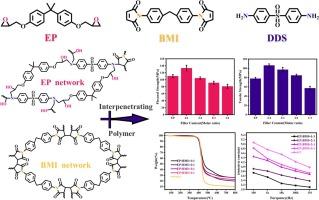Hierarchical curing mechanism in epoxy/bismaleimide composites: Enhancing mechanical properties without compromising thermal stabilities
IF 5.8
2区 化学
Q1 POLYMER SCIENCE
引用次数: 0
Abstract
It remains a considerable challenge to enhance mechanical properties without sacrifice of thermal properties in epoxy-based materials. In this study, epoxy/bismaleimide (EP/BMI) composites were synthesized via a melting blend technique using 4,4′-diaminodiphenylsulfone as the curing agent. It is found that there is a unique hierarchical curing mechanism in EP/BMI systems, including (i) respective curing of EP and BMI monomer, (ii) copolymerization between EP prepolymer and BMI monomer, (iii) homopolymerization of EP prepolymer and BMI oligomer. Via the hierarchical copolymerization, EP and BMI are compatible without phase separation phenomenon. The copolymerization concurrently improved the composites’ resistance to deformation under stress and restricted the thermal mobility of the polymer chains upon heat. Compared to pure EP resin, EP/BMI composite (4:1) shows a flexural strength of 133.6 MPa, tensile strength of 106.4 MPa and toughness of 3.6 MJ/m3 respectively, increased by 20.7 %, 36.4 % and 45.0 %. Meanwhile, Tg and Yc were also improved by 10.3 ℃ and 12.3 % in EP/BMI composite. Furthermore, the mechanical and thermal properties of the EP/BMI composites can be efficiently tailored by curing conditions and EP:BMI molar ratios. This discovery provides a significant benchmark for the design of composite material and to expand the application horizons for both EP and BMI materials.

环氧树脂/双马来酰亚胺复合材料的分层固化机制:在不影响热稳定性的前提下增强机械性能
如何在不牺牲环氧基材料热性能的前提下提高其机械性能,仍然是一项巨大的挑战。本研究采用 4,4′-二氨基二苯砜作为固化剂,通过熔融混合技术合成了环氧树脂/双马来酰亚胺(EP/BMI)复合材料。研究发现,EP/BMI 体系存在独特的分层固化机制,包括 (i) EP 和 BMI 单体各自固化,(ii) EP 预聚物和 BMI 单体共聚,(iii) EP 预聚物和 BMI 低聚物均聚。通过分层共聚,EP 和 BMI 相容,没有相分离现象。共聚同时提高了复合材料在应力作用下的抗变形能力,并限制了聚合物链在受热时的热流动性。与纯 EP 树脂相比,EP/BMI 复合材料(4:1)的弯曲强度为 133.6 兆帕、拉伸强度为 106.4 兆帕,韧性为 3.6 兆焦耳/立方米,分别提高了 20.7%、36.4% 和 45.0%。同时,EP/BMI 复合材料的 Tg 和 Yc 也分别提高了 10.3 ℃ 和 12.3%。此外,EP/BMI 复合材料的机械性能和热性能可通过固化条件和 EP:BMI 摩尔比进行有效定制。这一发现为复合材料的设计提供了一个重要基准,并拓展了 EP 和 BMI 材料的应用范围。
本文章由计算机程序翻译,如有差异,请以英文原文为准。
求助全文
约1分钟内获得全文
求助全文
来源期刊

European Polymer Journal
化学-高分子科学
CiteScore
9.90
自引率
10.00%
发文量
691
审稿时长
23 days
期刊介绍:
European Polymer Journal is dedicated to publishing work on fundamental and applied polymer chemistry and macromolecular materials. The journal covers all aspects of polymer synthesis, including polymerization mechanisms and chemical functional transformations, with a focus on novel polymers and the relationships between molecular structure and polymer properties. In addition, we welcome submissions on bio-based or renewable polymers, stimuli-responsive systems and polymer bio-hybrids. European Polymer Journal also publishes research on the biomedical application of polymers, including drug delivery and regenerative medicine. The main scope is covered but not limited to the following core research areas:
Polymer synthesis and functionalization
• Novel synthetic routes for polymerization, functional modification, controlled/living polymerization and precision polymers.
Stimuli-responsive polymers
• Including shape memory and self-healing polymers.
Supramolecular polymers and self-assembly
• Molecular recognition and higher order polymer structures.
Renewable and sustainable polymers
• Bio-based, biodegradable and anti-microbial polymers and polymeric bio-nanocomposites.
Polymers at interfaces and surfaces
• Chemistry and engineering of surfaces with biological relevance, including patterning, antifouling polymers and polymers for membrane applications.
Biomedical applications and nanomedicine
• Polymers for regenerative medicine, drug delivery molecular release and gene therapy
The scope of European Polymer Journal no longer includes Polymer Physics.
 求助内容:
求助内容: 应助结果提醒方式:
应助结果提醒方式:


